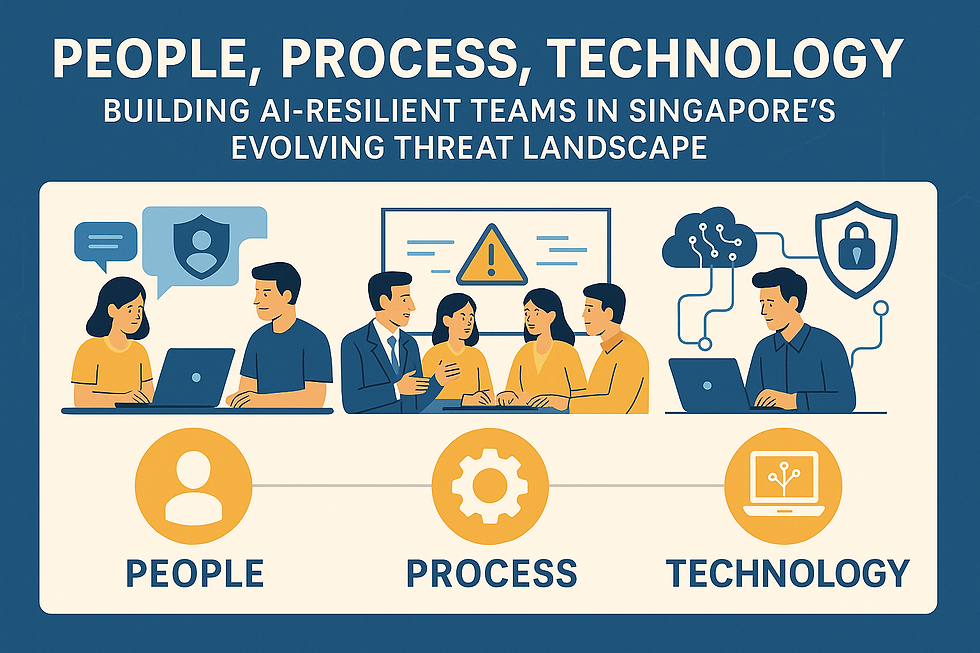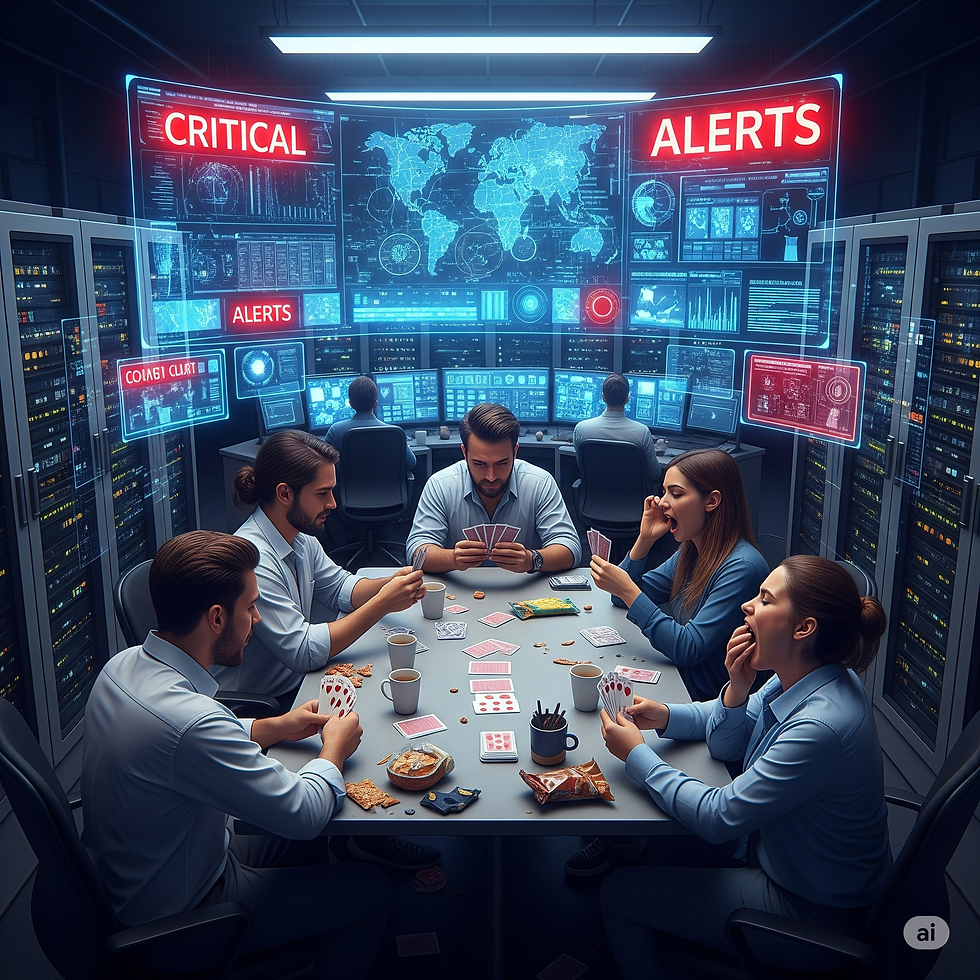People, Process, Technology: Building AI-Resilient Teams in Singapore’s Evolving Threat Landscape
- MZT

- 12 minutes ago
- 4 min read
By Momentum Z | August 2025
Introduction: The New Normal in Cyber Threats
In today’s hyperconnected Singapore, the threat landscape is shifting fast. With generative AI making phishing more convincing, malware smarter, and deepfakes more believable, small and medium enterprises (SMEs), healthcare institutions (MOH-linked), and non-profit social service agencies (SSAs under NCSS and AIC) are now facing risks once thought reserved for large enterprises.
Yet amid the noise around firewalls, AI-powered endpoint detection, and zero-trust architecture, we must ask:
Are your people ready?

Building an AI-resilient organisation in 2025 isn’t just about deploying the latest technology. It’s about empowering your people, reinforcing your processes, and leveraging technology as an enabler not a crutch.
Part I: Why People Are Still the Weakest (and Strongest) Link
AI threats don’t need to brute-force your firewall anymore they just need to fool one staff member. One click, one invoice fraud, or one impersonation of a department head can lead to catastrophic consequences.
"68% of attacks are linked to employees."
"15 Security Breaches Caused By Employees & How To Prevent Them" Teramind, March, 2025

Common AI-Enabled Threats Facing Teams Today:
Business Email Compromise (BEC) with perfect grammar and real-time local context.
Deepfake impersonations of C-suite leaders on video calls.
AI-generated malware that adapts to bypass defenses.
➤ Human-Centric Defense Begins with Awareness
Most employees don’t think they’re the target until it’s too late.
Practical staff training that goes beyond annual e-learning modules is vital. The most effective organisations adopt:
Bite-sized, scenario-based training monthly, not yearly.
Role-specific simulations (e.g., finance staff face fake invoice attacks, HR faces job application malware).
Gamified learning that ranks performance across teams to encourage peer learning.
Part II:
Process Is Your Lifeline in a Crisis
Technology may detect a breach. But how your people respond defines the impact.
An AI-resilient team does not panic it acts with clarity. That only comes from well-designed, well-practised incident response processes.
The Tabletop Exercise: Your Hidden Superpower
Tabletop exercises simulate cybersecurity incidents without touching your systems. They bring the leadership, operations, IT, and communications teams together to rehearse “what if” scenarios before disaster strikes.
“It was eye-opening. We realised our escalation tree was outdated and that no one had the media statement template.” – Feedback from a local SSA post-tabletop exercise
Realistic Scenarios for Tabletop Exercises:
AI-generated CEO voice instructs a fund transfer.
Deepfake video call from “vendor” requesting password reset.
Ransomware attack demanding payment in crypto with stolen medical records.
Internal data leakage from an AI chatbot integration.

Every tabletop run reveals gaps be it in contact lists, decision authority, or technical controls. More importantly, it builds muscle memory for crisis leadership.
Part III: Technology Is a Tool, Not a Silver Bullet
Singapore SMEs and SSAs often fall into two traps:
Over-reliance on tools without staff readiness.
Paralysis due to cost or complexity—leaving them exposed.
Yes, endpoint protection, email security, and cloud access controls matter. But without well-trained staff and a tested response plan, even the best tech is just… shelfware.

Technology should augment your team, not replace human vigilance. For example:
Use AI-based phishing simulators to tailor training to real-world threats.
Deploy attack surface management to alert staff to exposed credentials.
Leverage endpoint monitoring tools to feed insights into tabletop exercises.
Making it Work: Practical Steps for SMEs & Non-Profits
Whether you’re a charity with 30 staff or a private clinic under MOH guidelines, here’s how to start building AI-resilience today:
✅ Conduct a cyber awareness baseline survey – Understand your current team posture.
✅ Plan a tabletop exercise – Involve management, not just IT.
✅ Build a culture of “verify first, trust later” – Especially for finance and HR staff.
✅ Update incident playbooks – Include AI-specific threats.
✅ Engage a trusted partner – Especially one familiar with NCSS, IMDA, or CSA requirements.

Grants & Support You Might Not Know About
Good news: Singapore supports SMEs and SSAs on this journey.
NCSS Tech-and-Go! Grant: For charities and VWOs upgrading cybersecurity capabilities (up to 80% support).
Enterprise Singapore EDG: For SMEs building governance, risk, and compliance capabilities.
IMDA DPE / CSA Cyber Essentials: Simplified frameworks that include training and incident planning.
Do not let cost be the blocker there are pathways available for most organisations.
Final Thoughts: AI Resilience Starts With Leadership
Cybersecurity is no longer the IT department’s job. It’s a leadership issue especially in a world where AI can bypass even the best software.
In 2025, resilience means:
Leaders who understand the threat landscape.
Teams who’ve rehearsed their responses.
Technology that supports not supplants human vigilance.
Let’s stop talking about AI threats like science fiction. The threats are real. But so are the solutions when we empower people, align process, and deploy technology strategically.
About the Author
Momentum Z is a Singapore-based cybersecurity consultancy helping SMEs, charities, and healthcare institutions build practical resilience through training, tabletop exercises, and compliance alignment. We believe cybersecurity isn’t just about protection it’s about trust, continuity, and capability.



Comentarios